Fishing Lake Michigan with Walleye Gear
By Joel Ballweg-
Those of us who chase walleye in states like Minnesota, Wisconsin, North & South Dakota, Iowa & Illinois have all seen the reports & pictures from both charter boats and regulars on Lake Michigan. Those reports are often times backed up with some pretty impressive pictures of both big fish and quite often, lots of fish.
How many times have you thought to yourself: That sure does look like a lot of fun, I wonder if we could do that with our boat? And your next thought is probably something like: I wonder how much all that gear cost?
The truth is you don’t really have to buy a ton of gear to get started. Granted, you may not be able to take advantage of every bite going on out on Lake Michigan with walleye gear, but for certain, there are bites going on throughout the year that you can do with the gear you probably already have.
Let’s take a little inventory of what most walleye guys already have in their boat that can be useful for fishing on Lake Michigan:
Trolling rods – check!
Planer boards – check!
Jigging rods – check!
Rod holders – check!
Jigs & blade baits – check!
Swim baits – check!
Berkley Gulp – check!
With a few small additions to that line-up above, you can definitely get in on some of the action without breaking the bank. And if you decide to take it to the next level, which many people do, then you can always add a new piece of equipment each year. This is a very common route for many seasoned Lake Michigan anglers. Start small, and build your arsenal a little at a time each year.
Let’s take a seasonal look at how you can get in on the action now using your current gear & setup.
Cold weather, open water fishing in winter:
Starting with the winter months of December, January & February, there’s a lot of good fishing going on inside many of the harbor walls along the entire coast line of Lake Michigan. During the coldest parts of winter, these waters may be frozen over but generally they’re not frozen over for the entire winter and there’s a lot of nice fish being caught from small boats. Lake trout and brown trout are the most common species to be caught at this time of the year although I have caught an occasional walleye while fishing in the Milwaukee harbor in February.
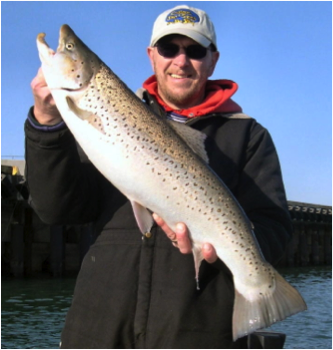 You should always check the regulations for the area you’re fishing but in general, lake trout season is closed during the winter months. It’s not illegal to catch one and take a few pictures but it is illegal to keep a lake trout between Oct 31st & March 1st. Both the brown trout and the lake trout are a ton of fun to catch on walleye jigging rods and there are some big ones out there that will test both you and your equipment.
You should always check the regulations for the area you’re fishing but in general, lake trout season is closed during the winter months. It’s not illegal to catch one and take a few pictures but it is illegal to keep a lake trout between Oct 31st & March 1st. Both the brown trout and the lake trout are a ton of fun to catch on walleye jigging rods and there are some big ones out there that will test both you and your equipment.
All you need to get in on this action is some warm clothes, a good jigging rod loaded up with plenty of line, a handful of jigs from 3/8 to 5/8oz and a bucket of Berkley Gulp minnows. I like the 4” minnows in chartreuse, white or anything that looks like an alewife, minnow or shad. Shad style paddle tails and blade baits also work extremely well at times.
I use a St Croix MLXF or MLF spinning rod. For line, I load up with 10# Sufix 832 Advanced Super line in neon lime.
This is the same line I use all the time for walleye fishing so I really don’t have to change anything when it comes to my rod & reel. The line diameter of Sufix Advanced Super line is small enough that you can spool up a lot of line on your typical walleye reel. Although it’s kind of rare to get spooled during the winter months, it can happen pretty quickly when jigging big kings later on in the year. If you spool up correctly now with a good braided line, you’ll also be ready to try jigging the harbor later in the year when the possibility of getting spooled by a big king becomes a real threat. For leaders, I prefer a 20# fluoro carbon leader of about 4-6’ long on the business end. When it comes to leaders, it never hurts to add a little stealth to your presentation.
Prime areas to jig and/or cast would be gaps in the harbor walls or any warm water discharges that may be in the area. You can also use your electronics to search for fish before targeting them vertically. The same techniques you use to entice walleyes to bite will also work for both lake and brown trout. The one major difference is you should also spend a fair amount of time jigging further off the bottom than what you might do when walleye fishing. It’s not uncommon to catch fish 2, 3 or even 4’ or more off the bottom.
A 16’ walleye boat is actually much better suited for this type of cold weather fishing than a bigger boat is. The one major concern that you do need to keep an eye out for is floating ice. You need to watch the wind and pay attention to whether or not the wind is pushing a large floating ice field back into the harbor or between the area you’re fishing and the boat launch you need to get back to.
Trolling for Brown Trout at Ice Out:
Brown trout fishing in Door County, Wisconsin is where it all began for me. It was some time back in the 1970’s when my older brother Dennis and his friends would take me along to Door County in April to troll for brown trout.
I remember it being darn cold but worth it when we got into fish. At times, that was some fast action.
Years later, I started pulling my 16’ Alumacraft up with nothing more than your standard walleye trolling rods, planer boards and a couple boxes of rapalas. In the early years, prior to the zebra mussel invasion, #13 jointed rapalas were standard. After the zebra mussel invasion, F7’s thru F13’s were our “go to” baits with a few husky jerks mixed in.
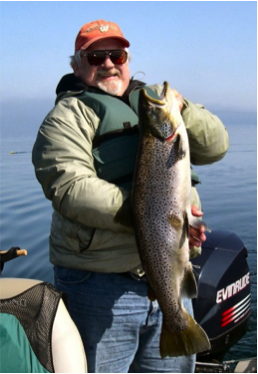 Initially we only targeted the protected bays such as Bailey’s Harbor, Rowley’s Bay, Egg Harbor & Sister Bay but after a few years, we quickly expanded the areas we would fish to include pretty much everything north of the Door County line. Door County area waters in particular are great for small boats because of all the options you have. No matter what direction the wind blows from, you can pretty much always find a place to fish, even in a small boat.
Initially we only targeted the protected bays such as Bailey’s Harbor, Rowley’s Bay, Egg Harbor & Sister Bay but after a few years, we quickly expanded the areas we would fish to include pretty much everything north of the Door County line. Door County area waters in particular are great for small boats because of all the options you have. No matter what direction the wind blows from, you can pretty much always find a place to fish, even in a small boat.
Our primary method of fishing was to troll small to medium size stick baits behind planer boards. Walleye trolling rods worked just fine for this although there were a few times when a really big brown trout would test the limits of our gear and skill as anglers. We didn’t always win those battles and sometimes our gear just wasn’t strong enough to handle the size of the fish pulling on the other end. But that’s what good fish stories are made of.
The fishing part is actually pretty easy. We usually deployed 3 boards per side and ran baits out 120’ behind the boards. The more important part is locating fish. Trolling around nilly-willy in big water isn’t going to be a lot of fun if you don’t know what you should be looking for. Fortunately, there are some very distinct areas that will almost always hold decent numbers of fish.
Early and late in the day, you can almost always pull a couple of fish from the shallow waters near the shore line.
Many times we found fish up in 3 to 4’ of water. It is necessary to run your boards out as far as possible when targeting these shallow fish and if there are other boats around, the chances of those fish staying in the shallows are slim. The best shallow areas always had one thing in common, and that would be wind! A decent wind blowing into the shoreline will improve your chances considerably.
After the early morning bite in the shallows comes to an end, don’t pull the boat out of the water just yet. Brown trout will bite all day long if you can find them. What you want to look for is dirty water. Dirty water is almost always warmer water and it only needs to be a couple of degree’s warmer. In April, it was not uncommon for the average water temperature to run 35-39 degrees. If we found water over 40 degrees, or better yet in the 43-47 degree range, we knew that the fish would be there and in pretty much every case, that warmer water had a darker tint to it than the surrounding waters did. It does make brown trout pretty easy to target once you know what to look for.
In your search for warmer water, it pays to take note of where the wind has been blowing from for the past few days. Start your search for warmer water along the shorelines where the wind has been or is currently blowing into. Pay special attention to large fingers of land that hook out into the bay or lake. These inside corners are notorious for collecting warmer water when winds blow in that direction.
If the area collecting warmer, wind driven water has a sharp break line, so much the better. Adding structure to the warm water equation was kind of like winning the lotto when it came to brown trout fishing in April. But it’s definitely not a critical requirement. Fish were usually there either way.
There are times when the pockets of dirty, warmer water are off shore and over deep water. At times like this, it may be necessary to get your baits a bit deeper than they would go on a flat line. This can be accomplished by running in-line sinkers in front of our stick baits. The way we did this was to run a 1/2oz in-line keel sinker about 6’ in front of the stick bait. We would deploy the lure, in-line keel sinker and about 40’ of line, then snap on a planer board. This was our most common rigging when fishing over deeper water and it wasn’t uncommon to catch fish using this method while fishing in 30-40’ of water. Our best guess was that a 1/2oz keel sinker would take our baits to down about 15-20’ below the surface and because of how successful it was, it quickly became a staple for fishing over deep water. These days, lead core may accomplish this same thing even better than keel sinkers did back then.
Jigging for Harbor Kings in July & August:
This bite is wind driven but not so much in the way you would normally expect. Typically what needs to happen in order for the big kings to move in close enough to target with a jigging rod, is for west winds to push all the warm surface water off shore. This in turn causes the cold sub-surface water to well up on the shoreline from where the wind is blowing. Here on the western side of Lake Michigan, we look for a decent west wind to blow for a couple days, which in effect causes a lot of cold water to move in close to shore and especially in the gaps in the harbor wall. The bait fish seem to follow that cold water right into and around those gaps and the big kings follow, making them much easier to target with a jigging rod.
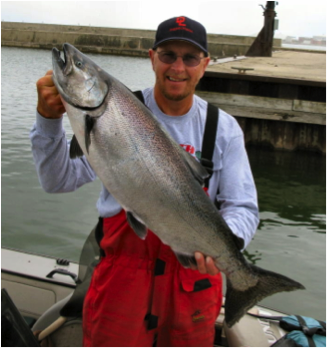 For gear, you can use the same setups and lures described earlier under the winter fishing segment of this article.
For gear, you can use the same setups and lures described earlier under the winter fishing segment of this article.
Basically, your standard walleye jigging rods with a lot of high quality braided line. Braid is kind of important here simply because of how much more line you can put on a spool. It does help to chase after these fish with the boat once they’re hooked but trust me when I tell you that quite often a big king can go a long way before your partner finally gets the boat moving in the right direction. This is when having a lot of line on your spool can make a huge difference in whether or not you actually land the fish.
The main areas you want to target are the gaps in the harbor wall and what you want to look for on your sonar, is large schools of alewives. You can up your chances of connecting with fish if you always try to stay near the schools of alewives and in the process, you will also notice large hooks moving around below these schools of bait fish. The best areas may be a 100 yards out into the main lake from the gap or they may be right in the middle of the gap but for sure, stay near the bait fish whenever possible and look for the large hooks indicating bigger fish are present. Not all of these fish are going to be ing salmon. It is not uncommon to hook into a brown trout or a steelhead and you may also come across a coho when the cold water moves close to shore.
You have two good options to catch these fish. One is to cast a jig & plastic and the other is to vertically jig a spoon or blade bait. Plastics will also work pretty well at times when vertically jigged. When casting, count the jig down to the desired level and then work it back to the boat with a snapping action. Snapping the rod tip during the retrieve will help create an erratic retrieve and that will definitely help increase the number of strikes you get. If you’re fishing in 30’ of water and you see good marks 20’ down, try to target those fish by casting out and counting down accordingly. You can quickly calculate how fast your bait is sinking by counting how long it takes to sink all the way to the bottom. From that starting point, it is easy to calculate how long to let your bait sink in order to target fish at specific depths before starting your retrieve after a cast.
If you are on the water at first light, and you should be, don’t forget to target the top 5-10’ of water. Do this by not allowing your bait to sink more than about 5 seconds before starting your retrieve. It’s common for these fish to reside high up in the water column during low light hours and more often than not, they will be very aggressive under these conditions. Learn to take advantage of this by keeping your lures up higher early in the morning.
The vertical bite is fun as well and maybe a little bit easier to do. It also allows you to target specific fish that you spot on the sonar. It’s really a simple matter of dropping down to the bottom, lifting the bait a few feet off the bottom and adding some jigging motions. Experiment with different jigging strokes but on average, a higher, longer and more aggressive jigging stroke is a good place to start. When you do get bit, set the hook hard. You definitely want to bury that hook. Many of these fish are big and the fights can be long so set the hook hard, keep the line tight at all times and be patient during the battle. With big fish on Lake Michigan, it doesn’t matter whether it’s a big brown trout or a big king salmon, either way you’re going to be battling that fish for up to 15 minutes or more. Trying to shorten the battle by horsing these fish to the net doesn’t usually end well for the angler. These fish will test your skill unlike any other fish you can catch in fresh water. Enjoy the battle, keep your cool and be patient!
Casting & Trolling Cranks for Big Kings in September & October
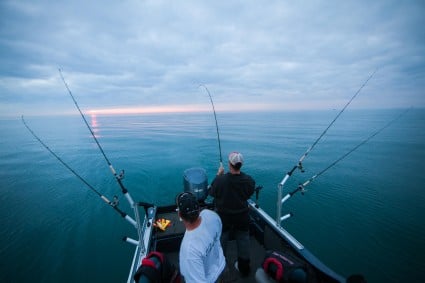 If you’ve never done this, you’re in for a real treat and for gear, you need nothing more than your favorite walleye trolling rods, a couple of planer boards and some good crank baits. For crank baits, there are a lot of good choices including Rapala Shad Raps, Tail Dancers, Storm Flicker Shads, and Smithwicks Deep Diving Rattling Rogue. Those will work great for starters but by no means should you limit yourself to those only as lots of other baits will also work well. When it comes to choosing a color, bright often works best. Firetiger, chartreuse & orange are always great choices but by no means your only choice. Try several and let the fish tell you which ones they like best. Baits with rattles in them can be especially good at times. It’s almost as if the fish are moody and smash these noisy lures just because they can’t stand to have a little crank bait rattling around down there.
If you’ve never done this, you’re in for a real treat and for gear, you need nothing more than your favorite walleye trolling rods, a couple of planer boards and some good crank baits. For crank baits, there are a lot of good choices including Rapala Shad Raps, Tail Dancers, Storm Flicker Shads, and Smithwicks Deep Diving Rattling Rogue. Those will work great for starters but by no means should you limit yourself to those only as lots of other baits will also work well. When it comes to choosing a color, bright often works best. Firetiger, chartreuse & orange are always great choices but by no means your only choice. Try several and let the fish tell you which ones they like best. Baits with rattles in them can be especially good at times. It’s almost as if the fish are moody and smash these noisy lures just because they can’t stand to have a little crank bait rattling around down there.
As for the details, this bite is going to happen primarily inside the harbor walls and gaps in the wall. No need to concentrate solely on the gaps though. Two things you want to see when doing this type of fishing is water temps around the mid-60’s and plenty of fish on the sonar. You’re not looking for bait fish here, you want to see arcs on the sonar and you also want to see fish porpoising on the surface as well. When you have arcs on the sonar and fish porpoising on the surface, you pretty much know its “go time”. In early September, water temps may be in the upper 60’s or even low 70’s. As long as you have some colder water below the surface and you have plenty of fish on the sonar, you should be able to catch them. Later in September and October, those surface temps may be down in the 50’s. You can still connect with fish at this time although they may be much darker in color as these fish are reaching the end of their life cycle.
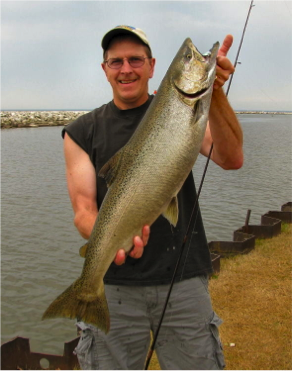 Many times you’ll be trolling or casting right up close to the rocks of the break wall or in amongst the sail boats moored in the inner harbor. This is one time where other boats motoring in and out of the harbor don’t seem to have much effect on the fish. They won’t spook and stop biting just from other boats slowly motoring overhead.
Many times you’ll be trolling or casting right up close to the rocks of the break wall or in amongst the sail boats moored in the inner harbor. This is one time where other boats motoring in and out of the harbor don’t seem to have much effect on the fish. They won’t spook and stop biting just from other boats slowly motoring overhead.
At the same time, this is not the time to run planer boards 100’ off to the side. Keep them tight to the boat. You only need the planer boards to separate you lines. Spreading lines way out in the confines of these tight, narrow areas where you’re going to be trolling will only cause problem between you and other boaters. In some of the smaller, tighter areas, it’s far better to pull the trolling rods and cast. Conflicts with others are less likely to occur and you will actually be able to target fish better by casting. Retrieve speeds should be slow but steady. Hits will be obvious as the fish seem as though there trying to kill your crank so make sure to hang on to your rod. Quite often it’s not even necessary to be in a boat as these fish are so close to the harbor walls that shore casting can be very effective as well.
This bite will go on day and night until well into October although the fish will become much darker in color and much less desirable on the table. In September, it’s still possible to catch silver sided kings but even then, they’re best smoked rather than grilled or baked. Pretty much all of these fish are four year old kings so they will for the most part be big fish nearing the end of their life cycle. They definitely provide for some fantastic, adrenaline producing action but not necessarily great table fare.
So there you have it! Four different bites, one for each season of the year and all of them can be done using the gear you probably already have in your boat. Lake Michigan can be intimidating for sure but with a little caution, it can also be some of the best fishing you will ever encounter. And like anything else, the more you do it, the better you’ll get at it. All it takes to get started is that first trip.
What are you waiting for?
About the author –
Joel Ballweg is a skilled multi-species angler and guide that can often be found chasing walleye, sauger and crappie with clients on Lake Wisconsin. Joel can be reach online at Joel Ballweg – Lake Wisconsin Fishing
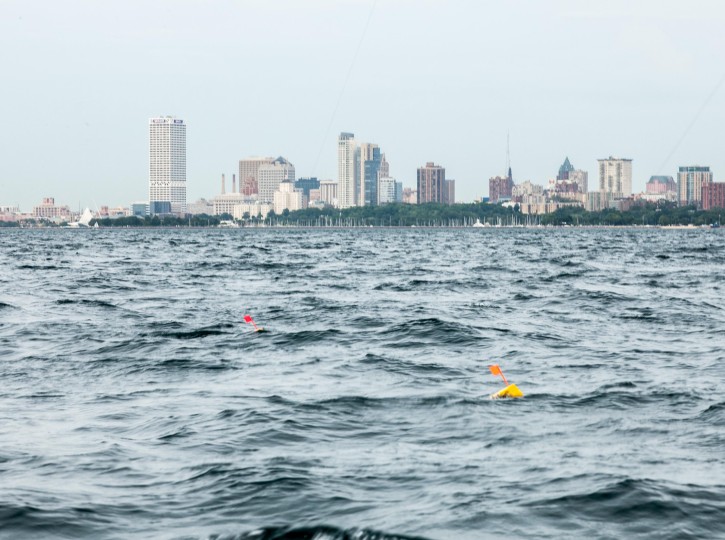
Love the article and all the effort!! Thank you. Missed the IDO get together, and I am like a sponge for this exact info, wanting to get into it. Caught a couple cohos this spring with my walleye gear, and really got the bug. These harbors being just minutes from my house helps.
The biggest thing I learned the day we caught our first few, was early in the year outside Bender (power plant area), we didn’t need to run the cranks deep. Up high on an overcast day seemed much better.
I seen a number of guys pulling flies on lead core “I think” in the later spring, or using dipsy divers… both of those are all new topics I want to understand, as I was told they are easy and somewhat affordable to get into.
Thank you again.
Cycle-Guy,
Quote: I seen a number of guys pulling flies on lead core “I think” in the later spring, or using dipsy divers… both of those are all new topics I want to understand, as I was told they are easy and somewhat affordable to get into.
I’m guessing your talking about the guys chasing coho in late April and early May. That’s a great bite to get in on and you are correct, it doesn’t cost a lot of money for gear to get started.
Typically they pull 6″ red colored flashers with peanut flys behind them. Lots of different peanut fly colors work but the red 6″ flasher is pretty much the standard.
There are some great articles out there already on how to do this.
Do a quick search for the following: “How to Troll Peanut Flies for Lake Michigan Coho”.
Regardless of the time of year, there’s some pretty darn good fishing down your way.